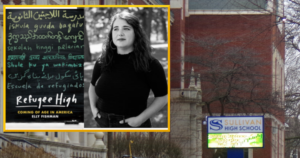It was 2017. President Trump had just taken office. One of his first acts was to declare a ban on incoming travelers from seven majority-Muslim nations, and Elly Fishman was angry.
“Like many people watching the news, I was shocked and motivated to protest what I thought were these draconian new rules, so I went to a protest at O’Hare Airport in Chicago,” she recalled. “While I was there, I was looking around and there were so many people holding up signs. … It made me think about who was on the other side of the wall. Who were these people who were stuck at immigration and unable to enter the country?”
So Fishman, who was a writer at Chicago Magazine at the time, began looking for refugee communities in Chicago. She was quickly pointed to Rogers Park, a neighborhood on the northeast side that is among the most diverse locales in the city.
“I’ve always written about young people. I’ve always been fascinated by how they see the world and how they move through the world. I was immediately curious about where young refugees landed, and it became clear quite quickly that Sullivan High School (in Rogers Park) was the place,” Fishman, now an instructor in UWM’s Journalism, Advertising, and Media Studies program, said.
She began speaking with students at the high school and her resulting article, “Welcome to Refugee High ,” was published in Chicago Magazine that summer.
“I spent two or three months reporting the article, and I felt like I barely touched the surface,” she said.
So, she wrote a book. Her debut work, “Refugee High: Coming of Age in America” was released on August 10.
Writing a refugee narrative
The book follows four students at Sullivan High for one school year. There is Belenge, who, though from the Congo, was born in a refugee camp in Tanzania; Shahina, a young woman from Myanmar who escaped an arranged marriage; and Alejandro, who, days before graduation, will find out if he is allowed asylum in the United States or will be deported back to Guatemala. Another young woman and her family fled from violence in Iraq.
Fishman was inspired to tell their stories in part because this is a part of refugee narratives that are rarely told: What happens after they flee war, famine, or oppression and are resettled in a new home?
Fishman spent the last three years with these students, visiting their houses, talking with them and their families, and exploring intimate details of their lives.
“Before I even started reporting or turned on my recorder, I would just have conversations with them: In the library, in the cafeteria, in the hallways, so we could build some amount of trust before we began embarking on what would become a three-year reporting process,” Fishman recalled.
Along the way, she uncovered harrowing stories of trauma, both in the teens’ countries of origin and in their new home. Belenge, for example, fled violence in the Congo only to see one of his friends shot in gang conflict in his new home in Chicago.
But as she reported their stories, Fishman found rays of light amidst the darkness of the students’ pasts.
“I think the beautiful thing about reporting out of a school is that you also see them be teenagers. You see them eat cafeteria food and gossip and do TikTok dances,” Fishman said. “Despite all of these individual traumas and burdens that they carry, there are so many experiences that teenagers across the globe share.”
Sullivan High School
There’s one more character in Fishman’s book: The school itself. Sullivan High School is a special place. For more than 100 years, it has welcomed students of every ethnicity and race. About half of its student body is made up of refugees or first-generation immigrants, hailing from 35 countries and speaking 38 languages.
Fishman was struck the first time she stepped through the doors.
“I’ve never been inside a building like that before,” she said. “It’s just this cacophony of sound. You hear Arabic and Swahili and Spanish and you see fashions from the Congo and Myanmar and Afghanistan mixed with American styles. I was completely blown away.”
And if Sullivan is a special place, its staff and teachers are exceptional. Fishman’s book also follows the school’s English Language Learner coordinator, Sarah Quintenz, who goes to such great lengths for her students that they call her “Mom.” Fishman also spotlights Chad Adams, the principal of Sullivan High School.
“He was struggling from the fallout of a very challenging assistant principalship at another Chicago High school that was, if not the most violent, one of the most violent high schools in Chicago. I think the fact that he was dealing with his own traumas made him a sympathetic leader at a school like Sullivan,” Fishman said.
She doesn’t shy away from people’s flaws – Fishman stresses the book isn’t a white savior narrative – but “I wanted to show the symbiotic relationship and the broader ecosystem in which all of these complicated and imperfect people exist – kids and teachers alike,” she said.
Fishman is still in contact with each of the students in her book, and she hopes that they’ll tell their own stories in their own words one day. Until then, you can find “Refugee High” at Boswell Books , on Amazon , or wherever books are sold.
Fishman also gave a presentation at Boswell Books on August 31.
By Sarah Vickery, College of Letters & Science
